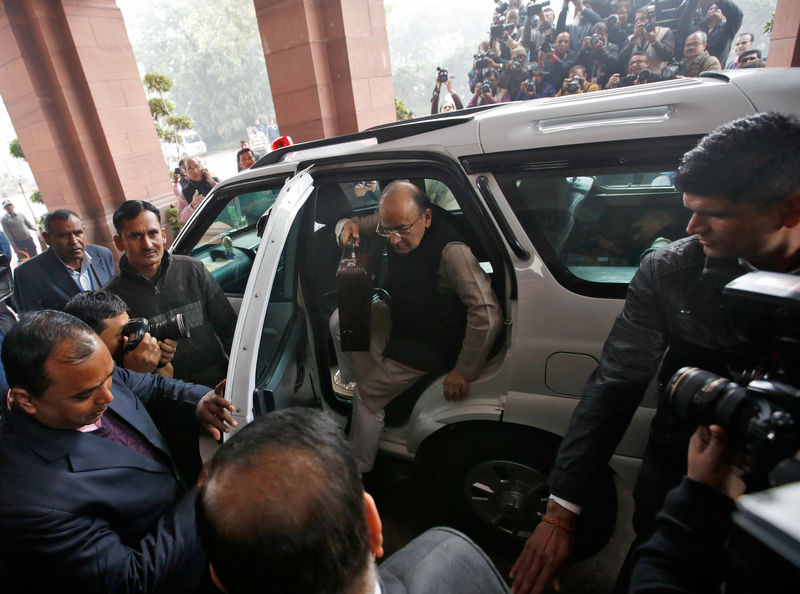By Rajesh Kumar Singh and Manoj Kumar
NEW DELHI (Reuters) - India unveiled a budget on Wednesday to help the poor with hikes in government spending and cuts in taxes as Prime Minister Narendra Modi seeks to win back the sympathy of voters hit hard by his recent crackdown on "black money".
Finance Minister Arun Jaitley announced increases in spending on rural areas, infrastructure and fighting poverty, and sought to assure lawmakers and the country that the economic impact of the government's cash crackdown would wear off soon.
Jaitley halved the basic personal income tax rate, and cut taxes on small firms that account for 96 percent of India's businesses, while imposing an income-tax surcharge on the better off.
"It's an election budget, to all intents and purposes, with a massive push on rural spending and some quite big tax cuts," said Shilan Shah, India economist at Capital Economics in Singapore.
The budget sops come days before India holds five regional elections that will influence whether Modi can win a second term as Indian leader in 2019.
"This budget is yet again devoted to the wellbeing of villages, farmers and the poor," the 66-year-old leader said in a national TV address after Jaitley delivered his two-hour budget speech.
DEFICIT SLIPPAGE
As economists polled by Reuters had expected, Jaitley raised the target for the federal fiscal deficit to 3.2 percent of gross domestic product in 2017/18 - effectively postponing the goal of bringing it down to 3 percent.
Economists, however, said that the sheer scale of the government's promises on tax cuts and spending increases cast Jaitley's higher deficit goal into doubt.
Balancing the books will depend on him hitting his target to sell 725 billion rupees ($10.7 billion) of state assets - or nearly 60 percent more than the expected proceeds this year.
"Jaitley is leaving room to exceed it at a later time," said Varun Khandelwal, managing director at Bullero Capital in New Delhi. The finance ministry estimates the deficit will come in at 3.2 percent this year, compared with its 3.5 percent target.
Indian shares rose 1.5 percent after Jaitley unveiled a range of incentives to boost infrastructure investment and develop the rural economy. But government bonds ticked lower on concerns over the higher deficit.
CASH CRUNCH
Modi's shock decision in November to scrap high-value banknotes worth 86 percent of India's cash in circulation has hit consumers, disrupted supply chains and hurt investment.
The worst of the cash crunch is now over, however, and Jaitley said he expected it would not spill over into the next fiscal year. Still, the finance ministry forecasts growth could dip as low as 6.5 percent this fiscal year before picking up to between 6.75 and 7.5 percent in 2017/18.
That is below the target rate of 8 percent or more that Modi needs to create enough jobs for the 1 million young Indians who enter the workforce each month.
While opinions vary on how long the disruptions caused by the crackdown on untaxed and illicit wealth will last, most analysts say Asia's third-largest economy needs a helping hand.
Jaitley hiked capital investment by 25.4 percent, and announced a 24 percent increase in rural and farm spending. Health spending will rise by 28 percent - as reported by Reuters earlier this week.
But there was no extra room to increase support for India's troubled state banks. Jaitley said he would pump in 100 billion rupees ($1.5 billion), in line with earlier plans.
TAX CUTS TO HELP POOR, SMALL BUSINESS
On the tax side, Jaitley's standout announcements were the halving of the lowest rate of personal tax to 5 percent that applies on incomes between 250,000 and 500,000 rupees ($3,700-$7,400). Better-off taxpayers will pay a 10 percent surcharge.
Small businesses with turnover up to 500 million rupees a year will see their tax rate cut to 25 percent from 30 percent. Taken together, the cuts in direct taxes would cost the public purse close to $3 billion.
In a surprise move, Jaitley said India would abolish the Foreign Investment Promotion Board, in a move to cut a layer of bureaucracy and make it easier to do business in India, which ranks a lowly 130th in a World Bank league table.
"Abolishing the FIPB will further boost foreign direct investment," said Pravin Kumar Agrawal, a tax partner at Deloitte Haskins & Sells.
Jaitley also announced a tightening of rules governing the funding of political parties, which are notorious for relying on undeclared donations to cover the vast expense of campaigning in the world's largest democracy.
This included slashing the maximum cash donation to 2,000 rupees ($30) and requiring parties to file income tax returns.
Jaitley's fiscal largesse will not only boost consumer spending, but may also shore up the fortunes of Modi's nationalist party in five regional elections for which voting begins on Saturday.
Punjab and Goa go to the polls first, to be followed by the big battleground state of Uttar Pradesh, and finally the small northern states of Uttarakhand and Manipur. Results of all five elections are due on March 11.
